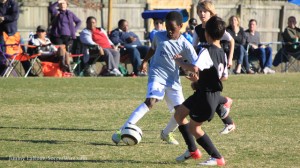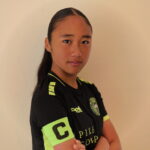Dure: A fully legal way to set up youth soccer leagues not strictly by birth year
The notion that the Chinese word for “crisis” includes a character for “opportunity” has been pretty well debated, if not outright refuted. If we could extract such literal meaning from multisyllabic words, we’d have to talk about “soccer” as it related to socks.
But in the Great Birth-Year Age Group Crisis of 2015-2017, we do indeed have an opportunity. U.S. Soccer’s mandates have caused great consternation and confusion.
Are you really telling me, parents are asking, that my kindergartner has to play his or her first soccer season with first-graders who are several steps ahead in maturity, having been in school for a year already? And are you telling us we can’t play with our classmates any more because we all think that’s the way it’s done in Europe, even though it’s not?
No, as it turns out. U.S. Soccer isn’t being quite as dictatorial as the mandates may appear.
+Read: O’Sullivan – Some thoughts on U.S. Soccer’s mandatory changes in youth soccer
The message isn’t clear. A U.S. Soccer handout of frequently asked questions on the new mandates seems unsympathetic to parental concerns at first, but then it leaves a lot of leeway for leagues, clubs and teams.
“The placement of individual players on specific teams will remain a function of the local club and league to help find the players the best possible environment for their development,” the handout says.
Also, the handout gives a few suggestions:
1. Play up! “U-8” means “8 and under.” If a lot of U-7 kids play U-8, then that team or league becomes a de facto 7/8 league, and U.S. Soccer has no objection to that. From the handout: “In addition to being on a team with their peers, ‘playing up’ can also allow players to compete in a more challenging environment, which can aid in their future development.”
2. In older age groups, mix it up! “An example of this would be a U11/12 team instead of separate U11 and U12 teams.”
3. Age groups could also be divided. “For younger ages, you could create teams based on the first and last 6 months of the year so that players are organized Jan. to June and July to Dec. Offering multiple teams per birth year can help diminish the effects of (Relative Age Effect) and assist with managing scholastic sport participation.”

U.S. Soccer Director of Coaching Dave Chesler draws a distinction between the administrative process of registration (birth-year age group) and the process of setting up teams and leagues:
“The recent change in registration is applicable primarily to the administrative functions of managing a large volume of player and family demographic data,” he told SoccerWire.com. “The organization of players into teams should be handled through application of best practices that are inherently linked to the development and safety of individual players. These variables must be directly assessed and acted upon through the guidance of local coaching leaders.
“Due to the dynamic nature of player development, the organizational leaders must adapt and problem-solve in order to create solutions to the alignment of players with teams. There are no specific rules to this process and there are very important best practices centered on player development.”
Add it up, and we get a slightly clearer picture. A lot of competitions, particularly at the more advanced age groups and levels of competition, will be strictly birth-year U-14, U-16, etc. Below that, we can be more creative.
+READ: Dure – Can a curriculum make a youth soccer club better?
With that in mind, here’s one way to set up your local league at the early ages, addressing these groups and their concerns:
Coaches:
They’d rather work with kids based on their developmental level, not strict chronological age. They know as well as anyone else that an aggressive 7-year-old who has been playing for two years has different needs than a shy 7-year-old playing for the first time.
Families:
Hate to break it to you, coaches, but parents know their kids better than you do. They know whether their 6-year-olds are already aggressive competitors who get excited by the prospect of playing with older kids, or whether their 7-year-olds are new to team sports and will shut down if you toss them in with a bunch of experienced U-8s. Some kids really need to play with friends; some are just happy if you have a ball and a couple of goals.
Everyone:
We all know we’re separating kids into “recreational” and “competitive” too early. It’s nonsensical to stamp a “non-competitive” label on an 8-year-old kid who showed up to a tryout in the middle of a growth spurt or before the light bulb had switched on in her head.
Some clubs are already mixing their “rec” and “competitive” kids. Arlington Soccer (Va.) does so and gives a persuasive argument in favor: “In many cases, mixing Travel and Rec kids on the same team helps all involved. The Travel kids revel in a more relaxed soccer environment, and they get to try things that might not be encouraged in the Travel environment. Smiles result. For the Rec kids, the exposure to Travel players may elevate their games. They may learn from their peers in ways that are invaluable. If, in keeping these players together on the field, the kids end up having a good deal of fun, then we’ve accomplished our mission.”
The USSF handout also hints at a permeable barrier: “There is no universal definition of what separates recreational from competitive soccer.”
 Here’s one way to smash that wall — while still giving advanced players more opportunities to improve, meeting families’ desires to get their kids in an appropriate level, and meeting the mandates.
Here’s one way to smash that wall — while still giving advanced players more opportunities to improve, meeting families’ desires to get their kids in an appropriate level, and meeting the mandates.
First Kick (U-5 and U-6):
For all U-5s and for any U-6s playing for the first time. Coaches teach basic skills, mostly dribbling, and games are 3v3.
Mini Kickers (U-6 and U-7):
Any U-6s who’ve played at least one season and feel comfortable playing (parents’ decision, though they can ask coaches for advice) will move up to this level, which also includes U-7s who have not yet moved up. Games are 4v4 as specified in USSF standards for U-6 and U-7.
Little Kickers (U-7 and U-8):
Experienced U-7s and inexperienced U-8s. Still parents’ choice, though coaches should be more proactive in giving advice. Games are still 4v4 as specified in USSF’s U-8 standards (same as U-6/U-7 but with longer game).
At these first three levels, clubs can offer additional training with pro coaches.
+READ: Dure: U.S. Soccer’s birth-year plan is shortsighted, helping coaches, not kids
Kickers (U-7 through U-9):
U-7s can only play if they try out, and it should be relatively rare. U-8s can play by parents’ choice as long as they have at least two seasons of experience. All U-9s are eligible. USSF’s U-9 standards for 7v7 games apply.
At this level, clubs’ additional training sessions start morphing into “travel” programs. They can play occasional scrimmages and a season-ending festival with other clubs, and they can select players for those scrimmages based on ability and coachability as demonstrated in the training sessions. Everyone plays, but the “elites” will start getting opportunities to play other elites. These scrimmages/festivals are where the age-group rules really kick in — U-8s play U-8s, U-9s play U-9s.
House Academy (U-8 through U-10):
U-8s and U-9s must try out. (Clubs should draw a high bar for U-8s and a lower one for U-9s.) All U-10s are eligible. This is the equivalent of Little League’s “Majors.”
 The additional training sessions continue as in Kickers — in fact, depending on the size of the club, it might be easier to combine Kickers and House Academy sessions or just organize them by age group. A U-8 or U-9 team for a season-ending festival may include some Kickers and some from House Academy.
The additional training sessions continue as in Kickers — in fact, depending on the size of the club, it might be easier to combine Kickers and House Academy sessions or just organize them by age group. A U-8 or U-9 team for a season-ending festival may include some Kickers and some from House Academy.
All U-10s, whether they’ve signed up for additional training sessions or not, get an opportunity to have at least two sessions per season with pro coaches and to play in a season-ending festival with neighboring clubs. That festival is tiered so you don’t have blowouts.
Club play (U-11 through U-19):
Now, all teams are organized by birth-year age groups. There’s no official distinction between “travel” and “rec.” But leagues may be designated as “elite,” “competitive” or “recreational.” Clubs will most likely save their pro coaches for “elite” and “competitive” leagues, but there’s no rule saying they must. Clubs will be encouraged to offer “competitive” soccer to all who want it and demonstrate the aptitude and commitment to play. All players have club passes — “elite” teams should borrow players from competitive teams, and competitive teams should borrow from recreational. The recreational leagues may just be within a couple of clubs to minimize travel.
+READ: U.S. Soccer announces coaching course changes, license upgrades
A few advantages of this plan:
1. No player is forced up into a level of competition for which he or she is not ready! If you just put in a U-6 league without any consideration to who’s in it, you’re going to have scared kindergartners being overwhelmed by first-graders who have a year of school structure to make them more mature, and you will run off players. I can’t emphasize enough what a serious problem this is, no matter how many elitist coaches scoff at it.
2. Players should get a good mix of playing with their classmates/neighbors while also easing into serious development and competition year by year.
3. Elite players still get to play elite soccer at U-9 and U-10. (Even if “elite soccer at U-9 and U-10” is kind of an oxymoron.) At least you can still put advanced players against advanced players in scrimmages and festivals.
4. We’ll finally start following U.S. Youth Soccer’s advice on when to start tryouts! (Or close to it — the U.S. Youth Soccer Player Development Model calls for no tryouts before U-13.) And we’ll erase the distinction between “competitive” and “recreational” that stigmatizes many kids, at least at an early age.
5. Nothing in this plan violates the U.S. Soccer mandates.
Go back and look again. Where you see “First Kick,” substitute “U-6.” “Little Kickers” are U-8. Giving them some name and not a number will encourage families to play up. (See your local baseball league if you don’t believe me.)
And someone out there is more creative than I am. (One of my college majors was music, but I did better in theory than in composition.) Someone can come up with better names than mine. And we can come up with good programs and good ways to encourage kids and their parents to come out and play.
We all know that good youth soccer coaches let kids be creative. We need to let the adults be creative as well. There is absolutely nothing in these mandates, nor anyone I know of at U.S. Soccer, who is telling us to shut off our brains.
And no one — absolutely no one — is telling us to treat 5-year-olds stepping onto a soccer field for the first time the same way we treat U-17s bound for the World Cup.
##
Beau Dure’s new book, Single-Digit Soccer: Keeping Sanity in the Earliest Ages of the Beautiful Game, is now available in paperback at Amazon and in electronic form at Amazon, Barnes and Noble, and other online booksellers. Read more about it at SportsMyriad.
SOCCERWIRE MARKETPLACE
- Capital Fall Classic 2025 - Register by October 1st
- Applications are Now Open for the 2026 Jefferson Cup
- Start the Season Strong at Loudoun Premier Cup!
- 50th Annual Rael Vodicka Memorial Tournament
- Soccer Marketing Internships at The St. James FC
- Job Opening: The St. James FC Goalkeeper Academy Coach
- Full-Time Director of Goalkeeping for The St. James FC
- visitRaleigh.com Showcase Series 2025, hosted by NCFC Youth
- Join Official Elite Summer Soccer Camps with Europe’s Top Pro Clubs!
- OFFICIAL BAYERN MUNICH SUMMER CAMPS U.S.











